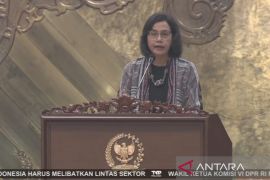Jakarta (ANTARA) - Regional governments need to play a more significant role in adaptive social protection programs, according to Dinar Dana Kharisma, the social aid coordinator at the National Development Planning Ministry/National Development Planning Board (Bappenas).
He made this statement during the seminar "Disaster Risk Financing & Insurance and Adaptive Social Protection Implementation in Indonesia," held by the Finance Minister on Monday. "The challenge with our social protection system is that it is still primarily controlled by the central government," he observed.
Therefore, there is still a relatively large role and space for regional governments to participate in, he added. Kharisma assessed that social protection from the central government is still too general. This has resulted in social protection programs being relatively similar across all regions, without considering the differing socioeconomic conditions in each province.
Thus, there needs to be more contribution from regional governments in the application and complementing of adaptive social protection. A strong contribution from regional governments can enhance the central government's social protection system at the regional level, Kharisma said.
In terms of natural disaster mitigation in Indonesia, adaptive social protection should be implemented. Adaptive social protection refers to a comprehensive approach that can be adapted to protect people from vulnerabilities. It includes risk protection for individuals, families, or communities on a large scale. Compared to regular social protection, adaptive social protection is more optimal in normal conditions and can adapt during emergency situations.
Kharisma then outlined specific strategies established by Bappenas for adaptive social protection. The first strategy is partnership and institutional strengthening. This involves building institutional relationships and cooperation between ministries and institutions related to Utilization Status Transfer (ASP).
Baca juga: Social granaries planned in Serasan Island
Baca juga: Sports allow relaxed setting for addressing bureaucratic issues
The second strategy is the availability and utilization of disaster data and information. The third strategy involves the integration of social protection programs. The fourth strategy focuses on financing, including social protection budget planning, in accordance with adequate risk layers.
Regions must get more involved in social protection: Bappenas

File - A busker dressed as a clown carries his child while walking in Mampang, Jakarta, on August 12, 2021. The National Development Planning Agency (Bappenas) will carry out social protection reforms to prevent an increase in the poverty rate. (ANTARA FOTO/M Risyal Hidayat/wsj)









